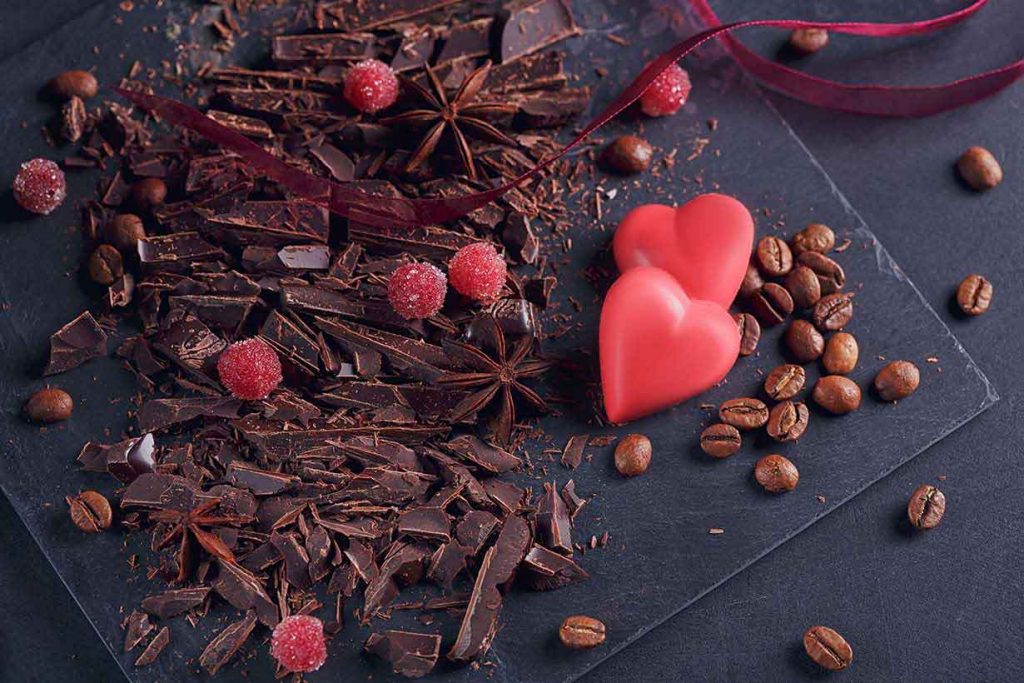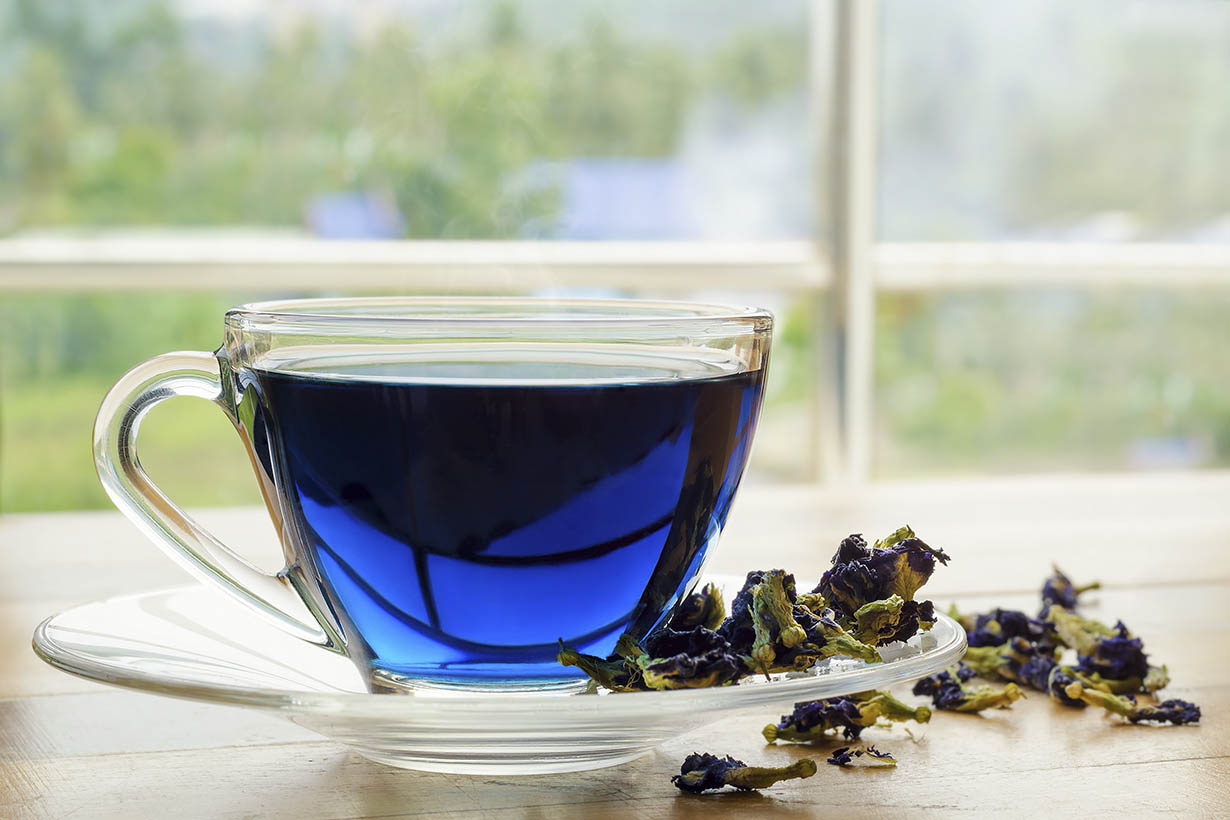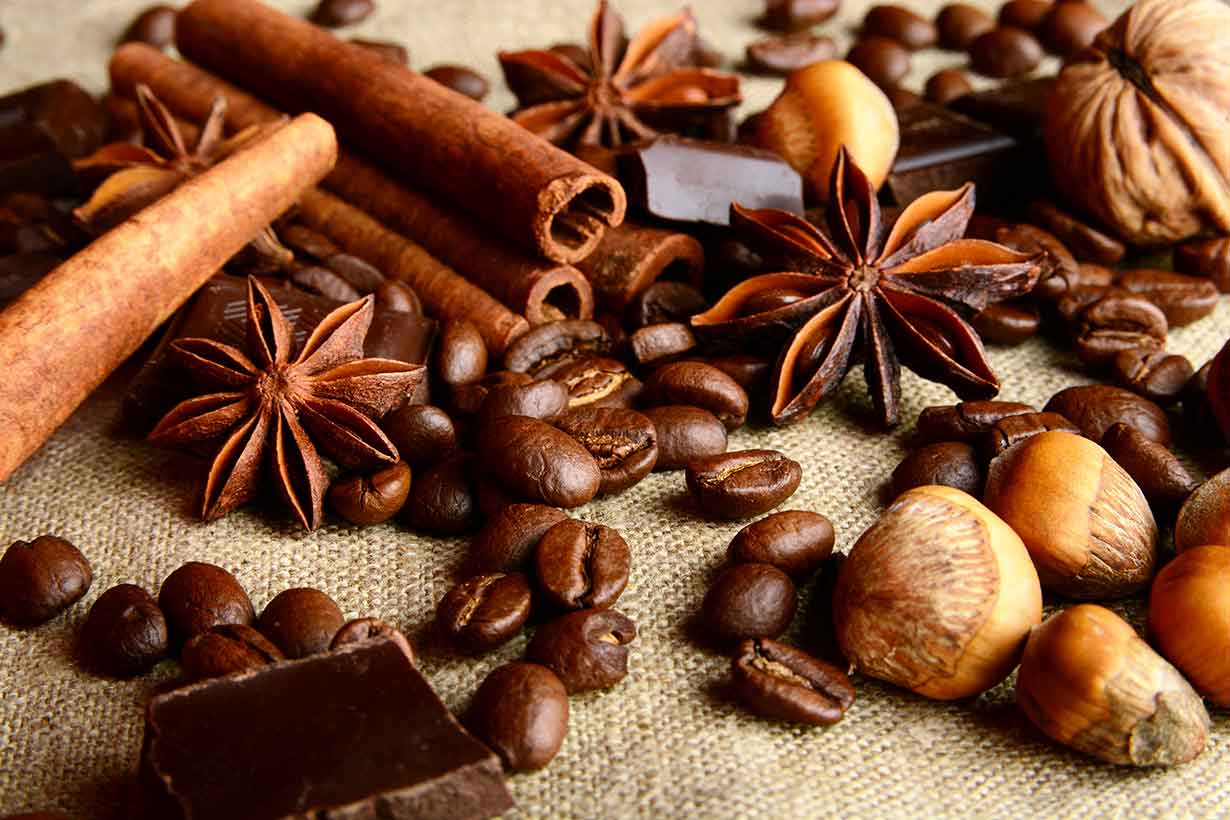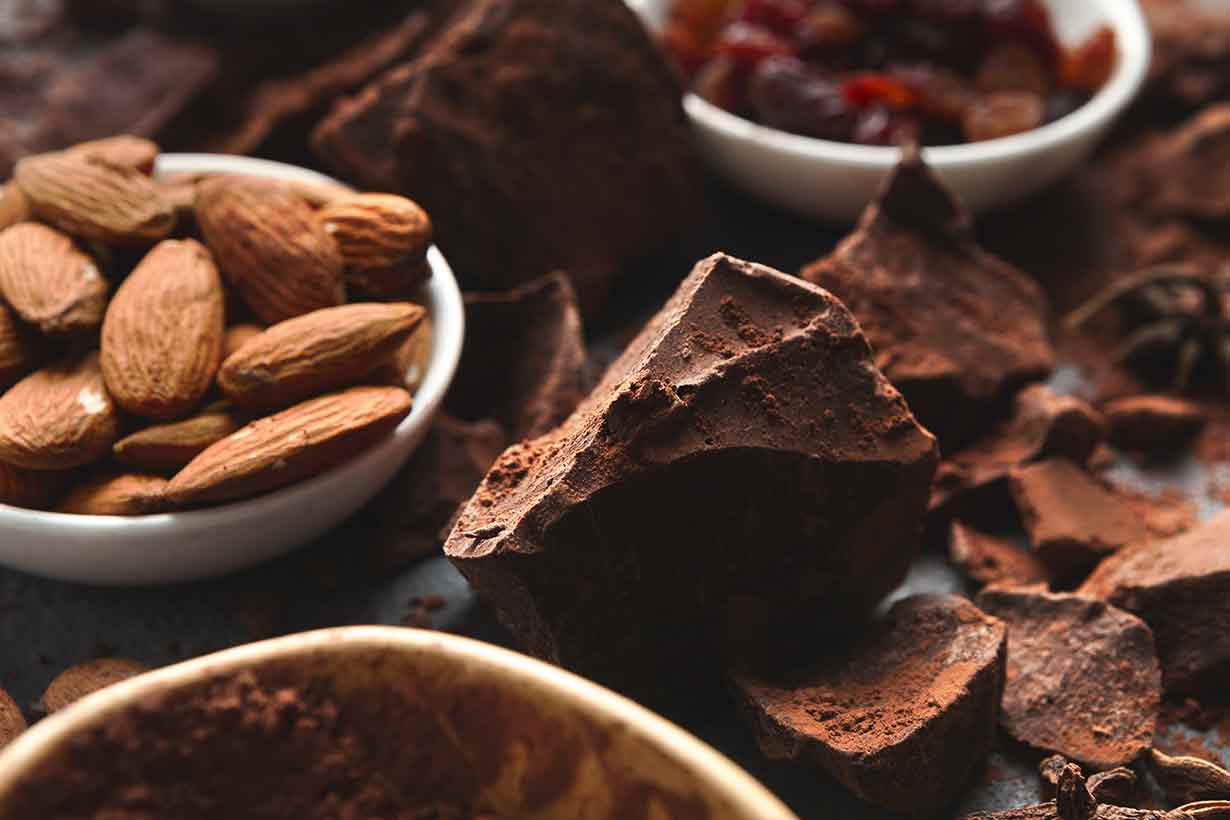Polyphenols are bioactive compounds thought to have benefits for human health, and they are present in a wide range of plant-based foods.
You may have heard discussions about “high polyphenol foods” in the media, with blueberries and cocoa being common mentions.
But for those curious about which foods have the most polyphenols, this article will provide the answers. In a scientific publication in the journal Nature, researchers identified the most polyphenol-rich foods based on test results published in the Phenol Explorer database (1, 2).
Based on the results of this research, this article presents 50 of the best dietary sources of polyphenols. For each food, you’ll learn its mean total polyphenol content and the most concentrated polyphenols it contains.
The Most Polyphenol-rich Foods
- Per gram: Based on polyphenol content per gram, the highest ranked foods are primarily dried herbs and spices. Foods with the most polyphenols per gram include cloves, dried peppermint leaves, star anise, and cocoa powder.
- Per typical serving: Dark chocolate, flaxseed meal, chestnuts, wild blueberries, and blackcurrants are some of the most polyphenol-rich foods per serving. This is because we tend to eat these foods in larger quantities than herbs and spices.
- Food groups: The food groups that have the highest concentrations of polyphenols are berries, herbs, nuts, seeds, and spices.
Important Note: The content in this article is for informational and educational purposes only. It should not replace medical advice from your healthcare provider.
Table of contents
A Ranking of 50 Foods High in Polyphenols (mg per 100g)

Before we begin this ranking list of polyphenol-rich foods, please note that the data is presented by total polyphenol content in milligrams (mg) per 100 grams, based on the values presented in the original study (1).
However, this ranking may not always translate to placing the best dietary polyphenol source first since how we consume each food can differ significantly.
For example, dried spices like cloves contain higher concentrations of polyphenols than blackberries per 100 grams, yet the typical serving size for cloves is less than a gram. On the other hand, consuming 100 grams of blackberries is a plausible serving size.
To help you understand this, we have also provided the typical serving size for each food based on data from the USDA FoodData Central database. From here, we have also calculated the total polyphenols ‘per serving’ from the raw per 100g data.
Where a USDA entry is unavailable, we have estimated the serving size based on common consumption.
1. Cloves (Dried)
- Total polyphenol content: 15,188 mg per 100g
- Main polyphenol classes: Flavonoids, hydroxyphenylpropenes, phenolic acids (3)
- Main specific polyphenols: Gallic acid, acetyl eugenol, eugenol
- Typical serving size: 1 tsp (2.1g) (4)
- Polyphenols per serving: 319 mg
2. Peppermint (Dried)
- Total polyphenol content: 11,961 mg per 100g
- Main polyphenol classes: Flavonoids, phenolic acids (5)
- Main specific polyphenols: Eriocitrin, rosmarinic acid, luteolin 7-O-rutinoside
- Typical serving size: 1 tsp (1.2g)
- Polyphenols per serving: 144 mg
3. Star Anise (Dried)
- Total polyphenol content: 5,460 mg per 100g
- Main polyphenol classes: Hydroxyphenylpropenes, phenolic acids (6)
- Main specific polyphenols: Anethole, protocatechuic acid, caffeic acid
- Typical serving size: 1/3 tsp (1g) (7)
- Polyphenols per serving: 55 mg
4. Cocoa Powder
- Total polyphenol content: 3,448 mg per 100g
- Main polyphenol classes: Flavonoids, hydroxybenzaldehydes, hydroxycoumarins, phenolic acids (8)
- Main specific polyphenols: Epicatechin, catechin, procyanidins
- Typical serving size: 1 tsp (5.4g) (9)
- Polyphenols per serving: 186 mg
5. Mexican Oregano (Dried)
- Total polyphenol content: 2,319 mg per 100g
- Main polyphenol classes: Flavonoids (10)
- Main specific polyphenols: Pinocembrin, naringenin, luteolin 7-O-glucoside
- Typical serving size: 1/4 tsp (0.3g) (11)
- Polyphenols per serving: 7 mg
6. Celery Seed (Dried)
- Total polyphenol content: 2,094 mg per 100g
- Main polyphenol classes: Flavonoids (12)
- Main specific polyphenols: Luteolin 7-O-(2-apiosyl-glucoside), chrysoeriol 7-O-apiosyl-glucoside, luteolin 7-O-(2-apiosyl-6-malonyl-glucoside)
- Typical serving size: 1 tsp (2g) (13)
- Polyphenols per serving: 42 mg
7. Black Chokeberry
- Total polyphenol content: 1,756 mg per 100g
- Main polyphenol classes: Anthocyanin flavonoids, phenolic acids (14)
- Main specific polyphenols: Cyanidin 3-O-galactoside, cyanidin 3-O-arabinoside, caffeic acid
- Typical serving size (fresh): 1/2 cup (100g)
- Polyphenols per serving: 1,756 mg
Note: Black chokeberries are extremely bitter and are typically processed into products like juices and jams rather than consumed in their fresh form.
8. Dark Chocolate
- Total polyphenol content: 1,664 mg per 100g
- Main polyphenol classes: Flavonoids, phenolic acids, stilbenes (15)
- Main specific polyphenols: Epicatechin, cinnamtannin A2, procyanidin dimer B2
- Typical serving size: 1 oz (28.35g) (16)
- Polyphenols per serving: 472 mg
9. Flaxseed Meal
- Total polyphenol content: 1,528 mg per 100g
- Main polyphenol classes: Lignans, phenolic acids (17)
- Main specific polyphenols: Ferulic acid 4-O-glucoside, p-Coumaric acid 4-O-glucoside, secoisolariciresinol
- Typical serving size (ground): 1 tbsp (7g) (18)
- Polyphenols per serving: 107 mg
10. Black Elderberries
- Total polyphenol content: 1,359 mg per 100g
- Main polyphenol classes: Flavonoids (19)
- Main specific polyphenols: Cyanidin 3-O-glucoside, cyanidin 3-O-sambubioside, quercetin
- Typical serving size (fresh): 1 cup (145g) (20)
- Polyphenols per serving: 1,970 mg
Note: Elderberries are typically consumed in processed products and should not be eaten raw.
11. Chestnuts
- Total polyphenols content: 1,215 mg per 100 g (raw weight)
- Main polyphenol classes: Flavonoids, phenolic acids (21)
- Main specific polyphenols: Ellagic acid, gallic acid
- Typical serving size: 100g (22)
- Polyphenols per serving: 1,215 mg
12. Sage (Dried)
- Total polyphenol content: 1,207 mg per 100g
- Main polyphenol classes: Phenolic acids (23)
- Main specific polyphenols: Rosmarinic acid, carnosic acid
- Typical serving size: 1 tsp (0.7g) (24)
- Polyphenols per serving: 8 mg
13. Rosemary (Dried)
- Total polyphenol content: 1,018 mg per 100g
- Main polyphenol classes: Flavonoids, phenolic acids (25)
- Main specific polyphenols: Rosmarinic acid, caffeic acid
- Typical serving size: 1 tsp (1.2g) (26)
- Polyphenols per serving: 12 mg
14. Spearmint (Dried)
- Total polyphenol content: 956 mg per 100g
- Main polyphenol classes: Phenolic acids (27)
- Main specific polyphenols: Rosmarinic acid, 5-Caffeoylquinic acid, caffeic acid
- Typical serving size (ground): 1 tsp (0.5g) (28)
- Polyphenols per serving: 5 mg
15. Thyme (Dried)
- Total polyphenol content: 878 mg per 100g
- Main polyphenol classes: Phenolic acids (29)
- Main specific polyphenols: Rosmarinic acid, caffeic acid, syringic acid
- Typical serving size (ground): 1 tsp (1.4g) (30)
- Polyphenols per serving: 12 mg
16. Wild Lowbush Blueberries
- Total polyphenol content: 836 mg per 100g
- Main polyphenol classes: Flavonoids, phenolic acids (31)
- Main specific polyphenols: 5-caffeoylquinic acid, malvidin 3-O-glucoside, malvidin 3-O-galactoside
- Typical serving size: 1 cup (148g) (32)
- Polyphenols per serving: 1,237 mg
17. Blackcurrants
- Total polyphenol content: 758 mg per 100g
- Main polyphenol classes: Flavonoids, phenolic acids (33)
- Main specific polyphenols: Delphinidin 3-O-rutinoside, cyanidin 3-O-rutinoside, delphinidin 3-O-glucoside
- Typical serving size: 1 cup (112g) (34)
- Polyphenols per serving: 849 mg
18. Capers
- Total polyphenol content: 654 mg per 100g
- Main polyphenol classes: Flavonoids (35)
- Main specific polyphenols: Quercetin 3-O-rutinoside, kaempferol 3-O-rutinoside, kaempferol
- Typical serving size: 1 tbsp (8.6g) (36)
- Polyphenols per serving: 56 mg
19. Black Olives
- Total polyphenol content: 569 mg per 100g
- Main polyphenol classes: Flavonoids, hydroxybenzaldehydes, phenolic acids, tyrosols (37)
- Main specific polyphenols: Oleuropein-aglycone, cyanidin 3-O-rutinoside, oleuropein
- Typical serving size: 3 olives (15g) (38)
- Polyphenols per serving: 85 mg
20. Highbush Blueberries (Cultivated)
- Total polyphenol content: 560 mg per 100g
- Main polyphenol classes: Flavonoids, hydroxybenzoic acids, hydroxycinnamic acids (39)
- Main specific polyphenols: 5-Caffeoylquinic acid, delphinidin 3-O-galactoside, malvidin 3-O-galactoside
- Typical serving size: 1 cup (148g) (40)
- Polyphenols per serving: 829 mg
21. Hazelnuts
- Total polyphenol content: 495 mg per 100g
- Main polyphenol classes: Flavonoids (41)
- Main specific polyphenols: Epigallocatechin, catechin
- Typical serving size: 1 oz (28.35g) (42)
- Polyphenols per serving: 140 mg
22. Pecan Nuts
- Total polyphenol content: 493 mg per 100g
- Main polyphenol classes: Flavonoids (43)
- Main specific polyphenols: Catechins, epigallocatechins
- Typical serving size: 1 oz (28.35g) (44)
- Polyphenols per serving: 140 mg
23. Soy Flour
- Total polyphenol content: 466 mg per 100g
- Main polyphenol classes: Flavonoids (45)
- Main specific polyphenols: 6″-O-Malonylgenistin, genistin, 6″-O-Malonyldaidzin
- Typical serving size: 1/4 cup (21g)
- Polyphenols per serving: 98 mg
Note: Soy flour is typically consumed as an ingredient in recipes. The serving size is estimated based on this.
24. Plums
- Total polyphenol content: 377 mg per 100g
- Main polyphenol classes: Flavonoids, phenolic acids (46)
- Main specific polyphenols: 3-Caffeoylquinic acid, cyanidin 3-O-rutinoside
- Typical serving size: 1 fruit (66g) (47)
- Polyphenols per serving: 249 mg
25. Green olives
- Total polyphenol content: 346 mg per 100g
- Main polyphenol classes: Flavonoids, phenolic acids, tyrosols (48)
- Main specific polyphenols: Oleuropein-aglycone, oleuropein, hydroxytyrosol
- Typical serving size: 3 olives (15g) (49)
- Polyphenols per serving: 52 mg
26. Basil (Dried)
- Total polyphenol content: 322 mg per 100g
- Main polyphenol classes: Phenolic acids (50)
- Main specific polyphenols: Rosmarinic acid, vanillic acid
- Typical serving size (ground): 1 tsp (1.4g) (51)
- Polyphenols per serving: 5 mg
27. Curry Powder
- Total polyphenol content: 285 mg per 100g
- Main polyphenol classes: Curcuminoids (52)
- Main specific polyphenols: Curcumin
- Typical serving size: 1 tsp (2.0g) (53)
- Polyphenols per serving: 6 mg
28. Sweet Cherry
- Total polyphenol content: 274 mg per 100g
- Main polyphenol classes: Flavonoids, phenolic acids (54)
- Main specific polyphenols: Cyanidin 3-O-rutinoside, 3-Caffeoylquinic acid, 3-p-Coumaroylquinic acid
- Typical serving size (with pits): 1 cup (138g) (55)
- Polyphenols per serving: 378 mg
29. Artichoke Heads (Raw)
- Total polyphenol content: 260 mg per 100g
- Main polyphenol classes: Flavonoids, phenolic acids (56)
- Main specific polyphenols: 5-Caffeoylquinic acid, luteolin
- Typical serving size: 1 medium (128g) (57)
- Polyphenols per serving: 333 mg
30. Blackberries
- Total polyphenol content: 260 mg per 100g
- Main polyphenol classes: Anthocyanin flavonoids, phenolic acids (58)
- Main specific polyphenols: Cyanidin 3-O-glucoside, ellagic acid, epicatechin
- Typical serving size: 1 cup (144g) (59)
- Polyphenols per serving: 374 mg
31. Soybeans (Roasted)
- Total polyphenol content: 246 mg per 100g
- Main polyphenol classes: Flavonoids (60)
- Main specific polyphenols: Genistin, 6″-O-Acetylgenistin, daidzin
- Typical serving size: 1 oz (28.35g)
- Polyphenols per serving: 70 mg
Note: The USDA lists a 172-gram cup serving for roasted soybeans, they are typically consumed in smaller portions, like nuts. The ‘typical serving size’ listed above is a more realistic portion.
32. Milk Chocolate
- Total polyphenol content: 236 mg per 100g
- Main polyphenol classes: Flavonoids (61)
- Main specific polyphenols: Epicatechin, catechin
- Typical serving size: 1 bar (44g) (62)
- Polyphenols per serving: 104 mg
33. Strawberries
- Total polyphenol content: 235 mg per 100g
- Main polyphenol classes: Flavonoids, phenolic acids, stilbenes (63)
- Main specific polyphenols: Pelargonidin 3-O-glucoside, pelargonidin 3-O-(6″-succinyl-glucoside), pelargonidin 3-O-(6″-malonyl-glucoside)
- Typical serving size: 1 cup (144g) (64)
- Polyphenols per serving: 338 mg
34. Red Chicory (Raw)
- Total polyphenol content: 235 mg per 100g
- Main polyphenol classes: Phenolic acids (65)
- Main specific polyphenols: 5-Caffeoylquinic acid, chicoric acid, protocatechuic acid
- Typical serving size: 1 cup (29g) (66)
- Polyphenols per serving: 68 mg
35. Raspberries
- Total polyphenol content: 215 mg per 100g
- Main polyphenol classes: Flavonoids, phenolic acids (67)
- Main specific polyphenols: Sanguiin H-6, cyanidin 3-O-sophoroside, lambertianin C
- Typical serving size: 1 cup (123g) (68)
- Polyphenols per serving: 264 mg
36. Filtered Coffee
- Total polyphenol content: 214 mg per 100g
- Main polyphenol classes: Methoxyphenols, phenolic acids (69)
- Main specific polyphenols: 5-Caffeoylquinic acid, 4-Caffeoylquinic acid, 3-Caffeoylquinic acid
- Typical serving size: 1 cup (237g) (70)
- Polyphenols per serving: 507 mg
Note: Drinks like coffee, cocoa, and tea can be very high in polyphenols.
Learn more here: 13 Drinks High in Polyphenols
37. Ginger (Dried)
- Total polyphenol content: 202 mg per 100g
- Main polyphenol classes: Hydroxyphenylpropenes, phenolic acids (71)
- Main specific polyphenols: [6]-Gingerol, caffeic acid
- Typical serving size (ground): 1 tsp (1.8g) (72)
- Polyphenols per serving: 4 mg
38. Wholegrain Hard Wheat Flour
- Total polyphenol content: 201 mg per 100g
- Main polyphenol classes: Phenolic acids (73)
- Main specific polyphenols: Ferulic acid
- Typical serving size: 1/4 cup (approx 30g)
- Polyphenols per serving: 60 mg
Note: Whole wheat flour is typically consumed as an ingredient in recipes. The serving size is estimated based on this.
39. Prunes
- Total polyphenol content: 194 mg per 100g
- Main polyphenol classes: Flavonoids, phenolic acids (74)
- Main specific polyphenols: 3-Caffeoylquinic acid, 5-Caffeoylquinic acid, 4-Caffeoylquinic acid
- Typical serving size: 4-6 prunes (40g) (75)
- Polyphenols per serving: 78 mg
40. Almonds
- Total polyphenol content: 187 mg per 100g
- Main polyphenol classes: Flavonoids, phenolic acids (76)
- Main specific polyphenols: Epigallocatechin
- Typical serving size: 1 oz (28.35g) (77)
- Polyphenols per serving: 53 mg
41. Black Grapes
- Total polyphenol content: 169 mg per 100g
- Main polyphenol classes: Flavonoids, hydroxycinnamic acids, phenolic acids, stilbenes (78)
- Main specific polyphenols: Malvidin 3-O-glucoside, malvidin 3-O-(6″-p-coumaroyl-glucoside), malvidin 3-O-(6″-acetyl-glucoside)
- Typical serving size: 1 cup (151g) (79)
- Polyphenols per serving: 255 mg
42. Red Onion
- Total polyphenol content: 168 mg per 100g
- Main polyphenol classes: Flavonoids, phenolic acids (80)
- Main specific polyphenols: Quercetin 3,4′-O-glucoside, quercetin 4′-O-glucoside, delphinidin 3-O-glucosyl-glucoside
- Typical serving size: 1 small onion (70g) (81)
- Polyphenols per serving: 118 mg
43. Green Chicory (Raw)
- Total polyphenol content: 166 mg per 100g
- Main polyphenol classes: Phenolic acids (82)
- Main specific polyphenols: 5-Caffeoylquinic acid, chicoric acid, gallic acid
- Typical serving size: 1 cup (29g) (83)
- Polyphenols per serving: 48 mg
44. Thyme (Fresh)
- Total polyphenol content: 163 mg per 100g
- Main polyphenol classes: Flavonoids, phenolic acids (84)
- Main specific polyphenols: Rosmarinic acid, luteolin, hispidulin
- Typical serving size: 1 tsp (0.8g) (85)
- Polyphenols per serving: 1 mg
45. Maize Flour
- Total polyphenol content: 153 mg per 100g
- Main polyphenol classes: Phenolic acids (86)
- Main specific polyphenols: Trans-ferulic acid, p-Coumaric acid, Syringic acid
- Typical serving size: 1/4 cup (approx 30g)
- Polyphenols per serving: 46 mg
46. Tempeh
- Total polyphenol content: 148 mg per 100g
- Main polyphenol classes: Flavonoids (87)
- Main specific polyphenols: 6″-O-Malonylgenistin, 6″-O-Malonyldaidzin, genistin
- Typical serving size: 3.5 oz (100g) (88)
- Polyphenols per serving: 148 mg
47. Whole Grain Rye Flour
- Total polyphenol content: 143 mg per 100g
- Main polyphenol classes: Phenolic acids (89)
- Main specific polyphenols: 5-Nonadecylresorcinol, 5-Heneicosylresorcinol, 5-Heptadecylresorcinol
- Typical serving size: 1/4 cup (approx 30g)
- Polyphenols per serving: 43 mg
48. Apple
- Total polyphenol content: 136 mg per 100g
- Main polyphenol classes: Flavonoids (90)
- Main specific polyphenols: Quercetin 3-O-arabinoside, quercetin 3-O-galactoside, quercetin 3-O-rhamnoside
- Typical serving size: 1 small apple (129g) (91)
- Polyphenols per serving: 175 mg
49. Spinach (Raw)
- Total polyphenol content: 119 mg per 100g
- Main polyphenol classes: Flavonoids (92)
- Main specific polyphenols: Kaempferol, quercetin
- Typical serving size: 1 cup (30g) (93)
- Polyphenols per serving: 36 mg
50. Shallots
- Total polyphenol content: 113 mg per 100g
- Main polyphenol classes: Flavonoids, phenolic acids (94)
- Main specific polyphenols: Quercetin, Protocatechuic acid
- Typical serving size: 1 tbsp chopped (10g) (95)
- Polyphenols per serving: 11 mg
Top 20 Foods High in Polyphenols Per Serving
As previously mentioned, comparing the polyphenol content of foods per 100 grams is an accurate way to compare foods in a consistent way.
However, typical portions of each food can differ significantly.
With this in mind, here are the top 20 foods with the most polyphenols based on their realistic serving size.
Note: While black elderberries and chokeberries contain significant amounts of polyphenols per cup, they are typically processed into products like jams and powders. Therefore, they are not included in this list, which is based on realistic servings.
- Wild lowbush blueberries: 1,237 mg
- Chestnuts: 1,215 mg
- Blackcurrants: 849 mg
- Highbush blueberries: 829 mg
- Filtered coffee: 507 mg
- Dark chocolate: 472 mg
- Sweet cherries: 378 mg
- Blackberries: 374 mg
- Strawberries: 338 mg
- Artichoke heads: 333 mg
- Cloves: 319 mg
- Black grapes: 255 mg
- Plums: 249 mg
- Cocoa powder: 186 mg
- Apple: 175 mg
- Tempeh: 148 mg
- Peppermint: 144 mg
- Hazelnuts & pecan nuts: 140 mg
- Red onion: 118 mg
- Milk chocolate: 104 mg
Summary
As shown in this article, it is easy to find a wide range of polyphenol-rich foods in many food groups.
Cocoa products, coffee, fruit, and nuts tend to offer the most polyphenols per typical serving.
However, herbs and spices are the most concentrated sources of polyphenols per gram.
To learn more about different nutrients, see these nutrition guides.



